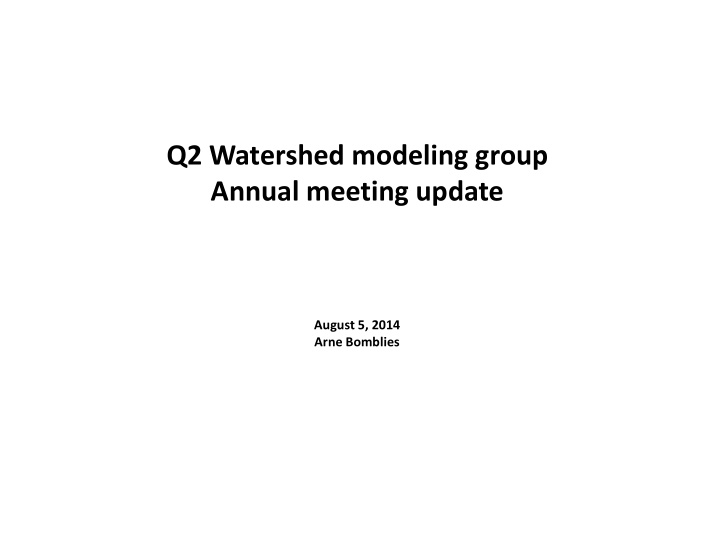



Q2 Watershed modeling group Annual meeting update August 5, 2014 Arne Bomblies
Question 2: Watershed component “Which alternative stable states can emerge in the watershed and lake resulting from non-linear dynamics of climate drivers, lake basin processes, social behavior, and policy decisions?” Global circulation Regional model climate model DHSVM watershed model ARIES lake dynamics integrated platform Governance and land use
Excerpt from a speech by Christina Tague http://fiesta.bren.ucsb.edu/~rhessys/index.html
Missisquoi Model 1997-1998 Water Year Observed and Simulated Runoff
Streamflow hydrograph Missisquoi River at Swanton 25 scenario 1 scenario 4 Streamflow scenario 2 scenario 5 scenario 3 scenario 6 20 (mm/day) 15 10 5 0 Nov Jan Mar May Jul Sep • • cali_gr_sh_fo_ag_IP & BNU_ESM rcp85 = scenario 1 pro-crop-LAPP & CESM1_BGC rcp85 = scenario 4 • • cali_gr_sh_fo_ag_IP & CESM1_BGC rcp85 = scenario 2 pro-forest-IP & BNU_ESM rcp85 = scenario 5 • • pro-crop-LAP & BNU_ESM rcp85 = scenario 3 pro-forest-IP & CESM1_BGC rcp85 = scenario 6
Original and Scenarios Comparison cali-gr-sh-fo-ag pro-crop-LAP pro-forest-IP Type Origin (%) IP 2041 (%) LAP 2041 (%) IP 2041 (%) Shrub 1.22 0.58 0.5 0.56 Grass 0.57 0.45 0.22 1.15 No Vegetation 26.26 27.63 55.8 15.92 Mixed Forest 24.97 24.57 13.67 24.61 Coniferous 8.4 7.88 3.8 7.91 Forest Deciduous 38.58 38.89 26 49.84 Forest Watershed drainage area is 2,200 km 2
MRV & Climate Input
Annual precipitation data over the Mad River Valley showing observed (black line) And five of the “best fit” GCM outputs.
1500 25 Precipitation Modeled Runoff (a) Modeled Runoff Observed Runoff Actual Runoff 20 Evapotranspiration Cumulative (mm) 1000 Storage 15 mm/day wet 10 500 5 0 0 1200 20 (b) Cumulative (mm) 15 800 mm/day average 600 10 400 5 200 0 0 (c) 20 1000 Cumulative (mm) 15 mm/day dry 600 10 5 200 0 0 Oct Dec Feb Apr Jun Aug Oct Dec Feb Apr Jun Aug
Model results: The number of days of flood exceedance (2175 cfs) per year. (from CMIP 5 ensembles)
Seasonality of Markov chain parameters: persistence in spring?
Distributed Hydrology Soil Vegetation Model Developed in early 1990s (Wigmosta et al., 1994) Updated by Lettenmaier and others at Pacific Northwest National Laboratory
Bank Stability and Toe Erosion Model Developed in the 1990s at USDA-ARS National Sedimentation Laboratory (Simon et al., 1999) Based on Limit Equilibrium analysis Source: http://ars.usda.gov/Research/docs.htm?docid=5045
BSTEM: Hydraulic processes Source: Simon et al., 2000 Critical shear stress: • Based on hydraulic stress required to mobilize sediment particles • Combines physical relationships and empirical methods Excess shear stress is that available to cause erosion: 𝜐 𝑓 = 𝜐 𝑝 − 𝜐 𝑑
Model Application to Shepherd Brook Mad River Watershed (144 𝐧𝐣 𝟑 ) Shepherd Brook sub-basin (17.2 𝐧𝐣 𝟑 ) Sub-watershed dimensions • 30 X 30 m resolution • 10 X 10 m for sediment routing • Cols, rows = 364, 318
Model Application to Shepherd Brook GIS-derived Inputs (for sub-basin) Field-derived Inputs • Meteorological data : Road/stream networks Road/stream networks temperature, RH, precipitation, shortwave/long-wave radiation, wind speed Soil depth Soil depth • Stream data: channel gradient, friction angle, initial Vegetation/land use bank geometry, roughness of channel Vegetation/land use bed • Soil/vegetation parameters: Soil type/classification Soil type/classification cohesion, saturated unit weight/bulk density, hydraulic conductivity, porosity, grain size distribution, roughness Elevation Elevation coefficient, rooting depths/soil layers, LAI Mask Mask
Model Application: Data for parameterization • Soil test pits: - information about soil layering - composition of soils - grain size distribution • Infiltration measurements: - range for saturated hydraulic conductivity • Jet testing/bore hole shear testing: - cohesion of bank materials - erodibility Lareau Farms soil test pit, summer 2013. • Piezometers and stage sensors: - water table elevation with respect to stream flow height Source: http://www.ars.usda.gov. Jet testing and bore hole shear testing for bank parameters.
Model Application: Data for calibration/validation • Discharge from Moretown USGS gauge • Turbidity measurements • Snow pack depths • LIDAR bank scans • Isotope data • Other modeling efforts
Recommend
More recommend